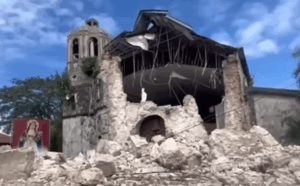MANILA — At least 69 people were killed and dozens more injured after a powerful 6.9 magnitude earthquake struck the central Philippines late Tuesday, one of the strongest to hit the country in decades.
The province of Cebu, which bore the brunt of the destruction, declared a state of calamity on Wednesday morning, as thousands of residents spent the night outdoors, rattled by repeated aftershocks and widespread power and water outages.
In the town of Bogo, close to the epicenter, body bags lined the streets while tent hospitals overflowed with patients. Officials warned of “a lot of damage” and appealed for medical volunteers to assist with mounting injuries.
Widespread Damage and Mounting Casualties
Most of the fatalities were reported in Bogo, where collapsed structures, buckled roads and fallen bridges have complicated rescue efforts. Seven victims lived in a village originally built to house survivors of Typhoon Haiyan in 2013, underscoring the community’s repeated vulnerability to disaster.
In nearby San Remigio, panic broke out during a local basketball game when the quake hit. Nearly 20 people were hospitalized, and one later died, emergency officials confirmed.
On Wednesday evening, Bogo was rattled again by a 4.7 magnitude aftershock, felt as far as Cebu City and the neighboring Leyte islands. No additional casualties were reported, but authorities warned of continuing risks.
National Response and International Concern
The Philippine national police and fire bureau have prioritized search and rescue operations, with teams working to restore electricity and deliver relief supplies. Communication has been hampered by downed power lines, making it difficult to reach affected families.
Cebu’s archbishop urged parishioners to avoid churches until engineers confirm their safety. Footage circulating online showed the tower of an old Catholic church swaying before partially collapsing, raising concerns about the region’s centuries-old heritage sites.
The National Disaster Risk Reduction and Management Council in Manila is coordinating relief efforts and verifying casualty reports. Officials cautioned that the death toll could rise as more areas become accessible.
A Nation Reeling From Successive Disasters
The quake comes just over a week after back-to-back typhoons killed more than 20 people and forced hundreds of thousands to evacuate. More than a dozen additional deaths were reported last month after tropical storm Bualoi and typhoon Ragasa battered the islands.
Situated along the Pacific “Ring of Fire,” the Philippines is one of the most disaster-prone countries in the world, its archipelago of more than 7,000 islands vulnerable to both typhoons and seismic upheavals. Experts note the country lies at the edge of the Philippine Plate, which is subducting beneath the Eurasian Plate, creating the friction that drives powerful earthquakes.
As night fell Wednesday, thousands of residents in Cebu and nearby provinces braced for more aftershocks, their fears compounded by fresh memories of typhoons and a long history of devastation. (zai)

